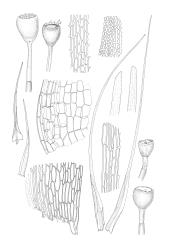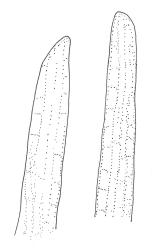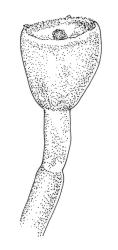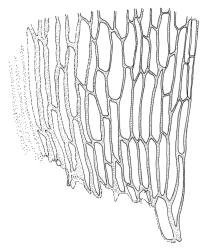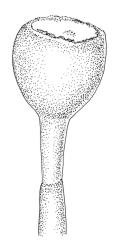- ≡ Blindiopsis immersa E.B.Bartram & Dixon in Dixon & Bartram, Bot. Not. 1937: 68 (1937)
Plants gold-brown or dark, dirty green, often brighter green near apices, not or weakly glossy. Stems commonly 40–90(–180) mm, flexuose, branching by forking and innovation, in cross-section with the cortical cells thick-walled in c. 3 layers, and with a faint central strand. Leaves flexuose-erect when dry, little altered when moist, often forming a ± penicillate terminal tuft, with an oblong base c. 2.0–2.5 mm long and gradually narrowed to a long, flexuose subula which is c. 3.5–5 times the base, entire, clasping at base, 8–11(–14) mm; upper laminal cells (from upper portion of the oblong base) linear-rectangular, mostly 45–90 × 6–10 µm, moderately incrassate, the lumina mostly expanded at cell ends, becoming shorter and ± rhombic or more irregular at shoulder; lower laminal cells similar; alar cells not differentiated. Costa (150–)200–275 µm wide and filling c. ⅔ of the leaf base, strong but ill-defined, the abaxial surface with short, rectangular cells, in cross-section with no differentiated guide cells.
Autoicous. Perichaetia often clustered at plant apex, sometimes overtopped by innovation; perichaetial leaves with a broader base and somewhat shorter than vegetative, otherwise similar. Perigonia on short branches directly below the perichaetia, the inner bracts short, broadly ovate and acute. Setae <0.5–1.0 mm, stout and erect, not twisted; capsules broadly turbinate when dry, becoming more hemispherical when moist and with age, immersed, yellow-brown with an orange rim, becoming dark brown with age, c. 0.8–1.0 long × 0.8–1.0 mm diam., often appearing gymnostomous under the stereoscope; exothecial cells regular in outline, oblong-hexagonal, mostly 25–50 µm in greater diam., moderately incrassate and not or only weakly collenchymatous, c. 3–5 rows thicker-walled and rounded to oblate at rim; stomata not seen; columella persistent; operculum long-rostrate from a conic base, c. 1.2 mm. Peristome rudimentary, with the teeth poorly formed and irregular, mostly extending c. 80–100 µm beyond the rim, distinctly red-pigmented and cribose. Spores 24–36 µm, green, smooth.
Dixon & Bartram 1937, fig. 3 (as Blindiopsis immersa); Bartlett & Vitt 1986, figs. 125–133, 154.
This species is most likely confused with B. lewinskyae. When sterile, B. immersa is best separated from B. lewinskyae by its ill-defined and broad costae, more flexuose stems, and shorter (mostly 45–90 µm vs mostly 90–200 µm long) cells in the upper portion of the leaf base. When fruiting, the very short seta of the present species readily distinguishes it from B. lewinskyae.
Although the capsules of B. immersa can be difficult to see, when they are located B. immersa could only be confused in N.Z. with B. martinii and B. contecta. Compared to the former, B. immersa is a more robust plant growing submerged rather than on damp rock. The present species has erect-flexuose, long subulate leaves with entire margins, which contrast with the falcate-secund, short-subulate, and denticulate leaves of B. martinii. Compared to B. contecta, the longer cells in the upper leaf base (mostly 45–90 µm vs 8–20 µm), the longer leaf subulae, and the shorter setae serve to separate the species. Their known distributions do not overlap.
Blindia immersa has been confused with Ditrichum strictum, but the latter is a coarser looking plant, with leaves thicker in appearance, twisted when dry, and distinctly rounded and toothed apically. Ditrichum strictum has a narrower and more clearly defined costa with a strong medial band of guide cells and exserted capsules.
SI: Nelson (Pikikiruna Range, Stockton Plateau), Westland or Otago (Martins Bay or Milford Sound); St (Glory Harbour, Pegasus Creek, Table Hill); Ch (Makara River); A.
Endemic.
On submerged rocks, often in or at the base of waterfalls; also from "granite sand in stream" through Chionochloa rubra grassland on the Stockton Plateau and "on silty bed of stream" near Pegasus Creek. The number of herbarium collections from the three Stewart I. localities suggests that B. immersa is abundant there. Cryptochila grandiflora (as Jamesoniella sonderi) was noted by Martin (in herb.) as an associate at Staircase Falls, Glory Harbour. The Stewart I. collections were made between sea level and c. 200 m elevation, while collections from the Stockton Plateau are from c. 700 m elevation.
There is confusion concerning both the provenance and the collection date of the lectotype and its duplicates. The protologue cites the Hutton collection (there cited as a syntype) from "Martin’s Bay, South I., 1874; coll. Capt. Hutton, herb. S. Berggren (B 105)". An isolectotype in WELT (M005033!) is labelled (apparently in W. Martin’s hand) as B 105, "Martin’s Bay, Ins. austr., Novae Zelandiae, 1874, Capt. Hutton". It bears supplementary notes (not relating to the specimen’s provenance) in Sainsbury’s hand. An apparent isolectotype in CHR (CHR 570797!) cites (in the hand of W. Martin) the provenance of this Hutton collection as "Milford Sound" and the year of collection as "1862?"). Berggren collected neither at Martins Bay nor Milford Sound during his 1874–75 travels in N.Z. The syntype of Capt. [F.W.] Hutton (subsequently lectotypified by Bartlett & Vitt) was probably collected in 1862, rather than 1874, and its origin may have been either Martins Bay (in Otago L.D.) or nearby Milford Sound (in Southland L.D.).
One of the Taramakau ["Teremakau"] paratypes (S. Berggren 226, CHR 570807!; WELT M005035!) cited by Dixon & Bartram (1937, p. 68) is referable to B. lewinskyae. Although neither S. Berggren 149 nor 30 have been seen, the reported occurrences of this species at Taramakau and Bealey are considered doubtful. The Pikikiruna Range record is based on J.K. Bartlett collections from "Moa Park" (c. 7 km east of Harwoods Hole, Nelson L.D.).
Bartlett & Vitt (1986, fig. 134) mapped four South I. localities (including "Moa Park", and both Martins Bay and Milford Sound). Their fourth locality is in the general vicinity of Hokitika (Westland L.D.) but no material has been confirmed from there.
The type collection is paler and more yellow-green than the bulk of herbarium collections, which are dark and often dirty green, with little or no lustre. The peristome is "of an irregular row of 1–3 hyaline cells" according to Bartlett & Vitt (1986), but in the few peristomate capsules I have seen, the irregular teeth are pigmented and as described above. Unfortunately, capsules in all the fruiting Stewart I. collections are rather old; sporophyte details in the description are primarily from Stockton Plateau collections made by D. Glenny (CHR).
A remarkable feature of this species is the apparent complete lack of guide cell development in the costae (although the median cells are larger than the peripheral cells); all could be interpreted as stereids.




